2016 NISSAN LEAF steering wheel
[x] Cancel search: steering wheelPage 324 of 437
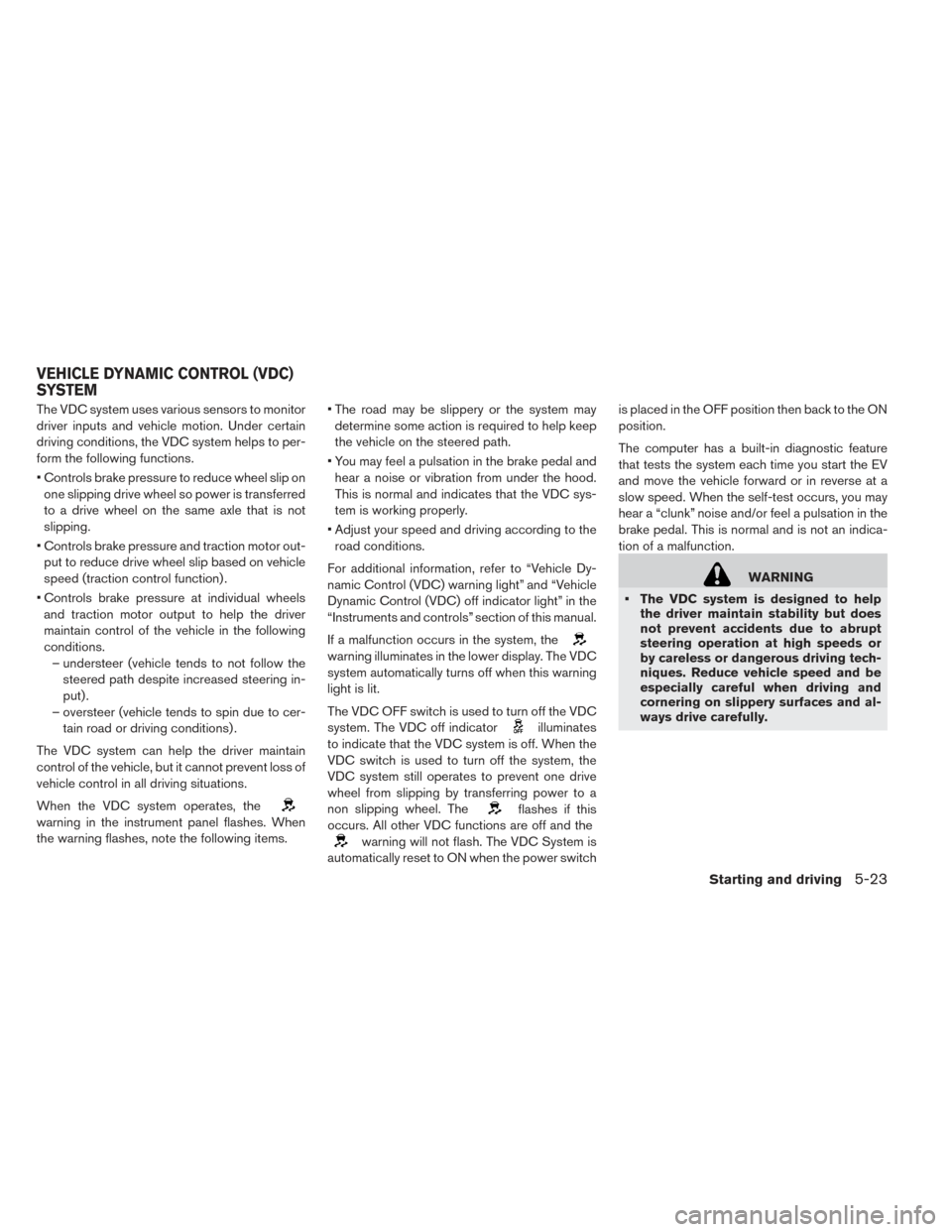
The VDC system uses various sensors to monitor
driver inputs and vehicle motion. Under certain
driving conditions, the VDC system helps to per-
form the following functions.
• Controls brake pressure to reduce wheel slip onone slipping drive wheel so power is transferred
to a drive wheel on the same axle that is not
slipping.
• Controls brake pressure and traction motor out- put to reduce drive wheel slip based on vehicle
speed (traction control function) .
• Controls brake pressure at individual wheels and traction motor output to help the driver
maintain control of the vehicle in the following
conditions. – understeer (vehicle tends to not follow the steered path despite increased steering in-
put) .
– oversteer (vehicle tends to spin due to cer- tain road or driving conditions) .
The VDC system can help the driver maintain
control of the vehicle, but it cannot prevent loss of
vehicle control in all driving situations.
When the VDC system operates, the
warning in the instrument panel flashes. When
the warning flashes, note the following items. • The road may be slippery or the system may
determine some action is required to help keep
the vehicle on the steered path.
• You may feel a pulsation in the brake pedal and hear a noise or vibration from under the hood.
This is normal and indicates that the VDC sys-
tem is working properly.
• Adjust your speed and driving according to the road conditions.
For additional information, refer to “Vehicle Dy-
namic Control (VDC) warning light” and “Vehicle
Dynamic Control (VDC) off indicator light” in the
“Instruments and controls” section of this manual.
If a malfunction occurs in the system, the
warning illuminates in the lower display. The VDC
system automatically turns off when this warning
light is lit.
The VDC OFF switch is used to turn off the VDC
system. The VDC off indicator
illuminates
to indicate that the VDC system is off. When the
VDC switch is used to turn off the system, the
VDC system still operates to prevent one drive
wheel from slipping by transferring power to a
non slipping wheel. The
flashes if this
occurs. All other VDC functions are off and the
warning will not flash. The VDC System is
automatically reset to ON when the power switch is placed in the OFF position then back to the ON
position.
The computer has a built-in diagnostic feature
that tests the system each time you start the EV
and move the vehicle forward or in reverse at a
slow speed. When the self-test occurs, you may
hear a “clunk” noise and/or feel a pulsation in the
brake pedal. This is normal and is not an indica-
tion of a malfunction.
WARNING
• The VDC system is designed to help the driver maintain stability but does
not prevent accidents due to abrupt
steering operation at high speeds or
by careless or dangerous driving tech-
niques. Reduce vehicle speed and be
especially careful when driving and
cornering on slippery surfaces and al-
ways drive carefully.
VEHICLE DYNAMIC CONTROL (VDC)
SYSTEM
Starting and driving5-23
Page 332 of 437
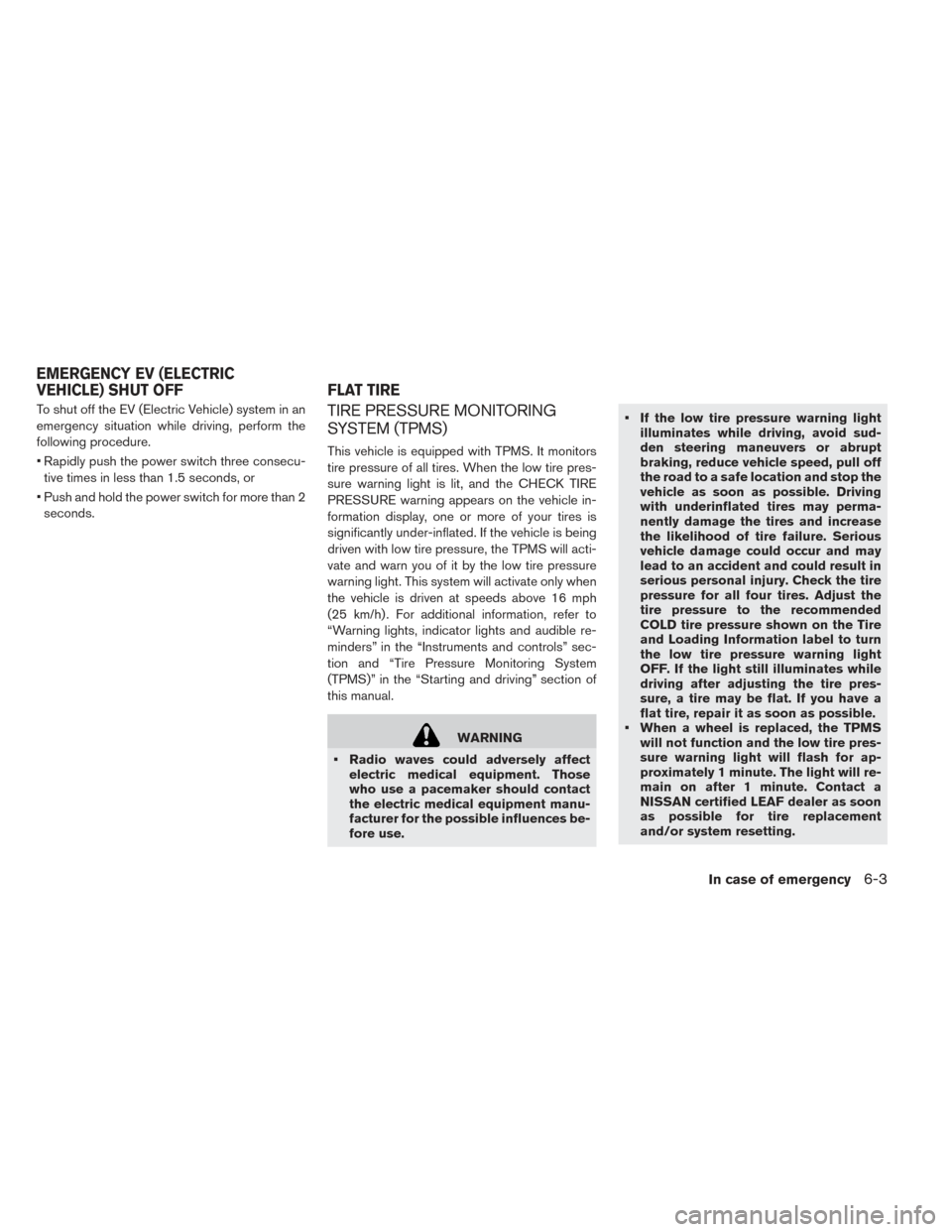
To shut off the EV (Electric Vehicle) system in an
emergency situation while driving, perform the
following procedure.
• Rapidly push the power switch three consecu-tive times in less than 1.5 seconds, or
• Push and hold the power switch for more than 2 seconds.TIRE PRESSURE MONITORING
SYSTEM (TPMS)
This vehicle is equipped with TPMS. It monitors
tire pressure of all tires. When the low tire pres-
sure warning light is lit, and the CHECK TIRE
PRESSURE warning appears on the vehicle in-
formation display, one or more of your tires is
significantly under-inflated. If the vehicle is being
driven with low tire pressure, the TPMS will acti-
vate and warn you of it by the low tire pressure
warning light. This system will activate only when
the vehicle is driven at speeds above 16 mph
(25 km/h) . For additional information, refer to
“Warning lights, indicator lights and audible re-
minders” in the “Instruments and controls” sec-
tion and “Tire Pressure Monitoring System
(TPMS)” in the “Starting and driving” section of
this manual.
WARNING
• Radio waves could adversely affect electric medical equipment. Those
who use a pacemaker should contact
the electric medical equipment manu-
facturer for the possible influences be-
fore use. • If the low tire pressure warning light
illuminates while driving, avoid sud-
den steering maneuvers or abrupt
braking, reduce vehicle speed, pull off
the road to a safe location and stop the
vehicle as soon as possible. Driving
with underinflated tires may perma-
nently damage the tires and increase
the likelihood of tire failure. Serious
vehicle damage could occur and may
lead to an accident and could result in
serious personal injury. Check the tire
pressure for all four tires. Adjust the
tire pressure to the recommended
COLD tire pressure shown on the Tire
and Loading Information label to turn
the low tire pressure warning light
OFF. If the light still illuminates while
driving after adjusting the tire pres-
sure, a tire may be flat. If you have a
flat tire, repair it as soon as possible.
• When a wheel is replaced, the TPMS will not function and the low tire pres-
sure warning light will flash for ap-
proximately 1 minute. The light will re-
main on after 1 minute. Contact a
NISSAN certified LEAF dealer as soon
as possible for tire replacement
and/or system resetting.
EMERGENCY EV (ELECTRIC
VEHICLE) SHUT OFF FLAT TIRE
In case of emergency6-3
Page 335 of 437
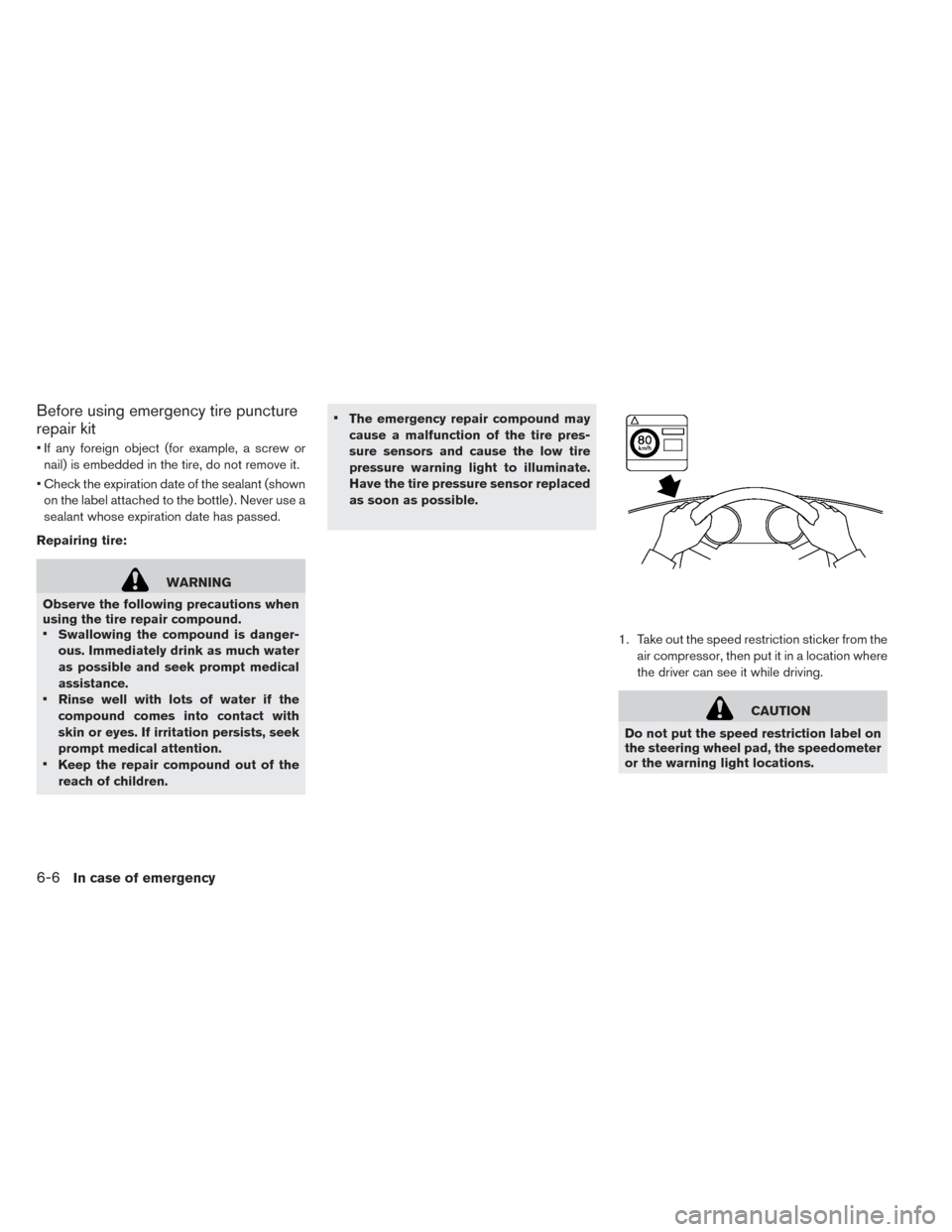
Before using emergency tire puncture
repair kit
• If any foreign object (for example, a screw ornail) is embedded in the tire, do not remove it.
• Check the expiration date of the sealant (shown on the label attached to the bottle) . Never use a
sealant whose expiration date has passed.
Repairing tire:
WARNING
Observe the following precautions when
using the tire repair compound.
• Swallowing the compound is danger-
ous. Immediately drink as much water
as possible and seek prompt medical
assistance.
• Rinse well with lots of water if the
compound comes into contact with
skin or eyes. If irritation persists, seek
prompt medical attention.
• Keep the repair compound out of the
reach of children. •
The emergency repair compound may
cause a malfunction of the tire pres-
sure sensors and cause the low tire
pressure warning light to illuminate.
Have the tire pressure sensor replaced
as soon as possible.
1. Take out the speed restriction sticker from theair compressor, then put it in a location where
the driver can see it while driving.
CAUTION
Do not put the speed restriction label on
the steering wheel pad, the speedometer
or the warning light locations.
6-6In case of emergency
Page 344 of 437
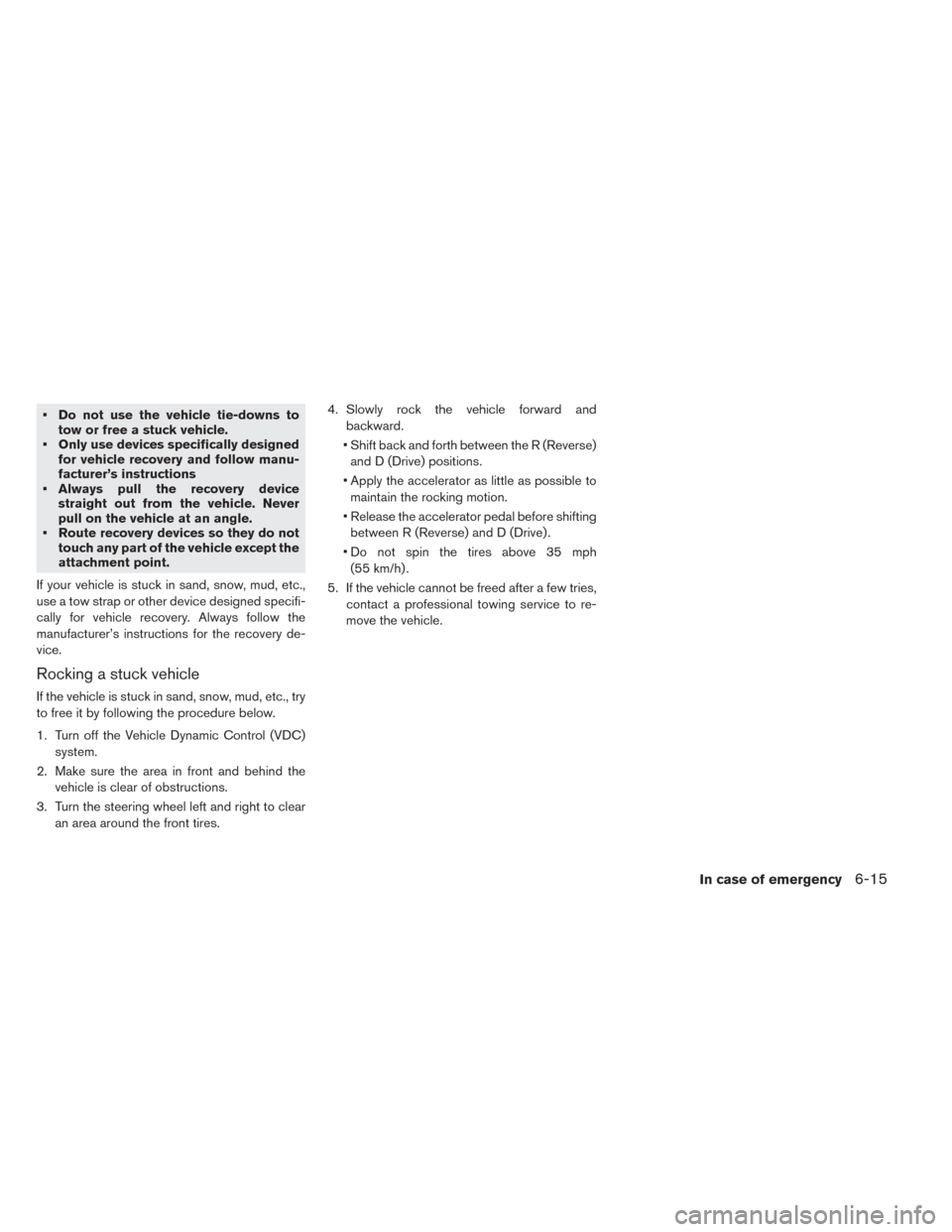
• Do not use the vehicle tie-downs totow or free a stuck vehicle.
• Only use devices specifically designed for vehicle recovery and follow manu-
facturer’s instructions
• Always pull the recovery device straight out from the vehicle. Never
pull on the vehicle at an angle.
• Route recovery devices so they do not touch any part of the vehicle except the
attachment point.
If your vehicle is stuck in sand, snow, mud, etc.,
use a tow strap or other device designed specifi-
cally for vehicle recovery. Always follow the
manufacturer’s instructions for the recovery de-
vice.
Rocking a stuck vehicle
If the vehicle is stuck in sand, snow, mud, etc., try
to free it by following the procedure below.
1. Turn off the Vehicle Dynamic Control (VDC) system.
2. Make sure the area in front and behind the vehicle is clear of obstructions.
3. Turn the steering wheel left and right to clear an area around the front tires. 4. Slowly rock the vehicle forward and
backward.
• Shift back and forth between the R (Reverse) and D (Drive) positions.
• Apply the accelerator as little as possible to maintain the rocking motion.
• Release the accelerator pedal before shifting between R (Reverse) and D (Drive) .
• Do not spin the tires above 35 mph (55 km/h) .
5. If the vehicle cannot be freed after a few tries, contact a professional towing service to re-
move the vehicle.
In case of emergency6-15
Page 356 of 437
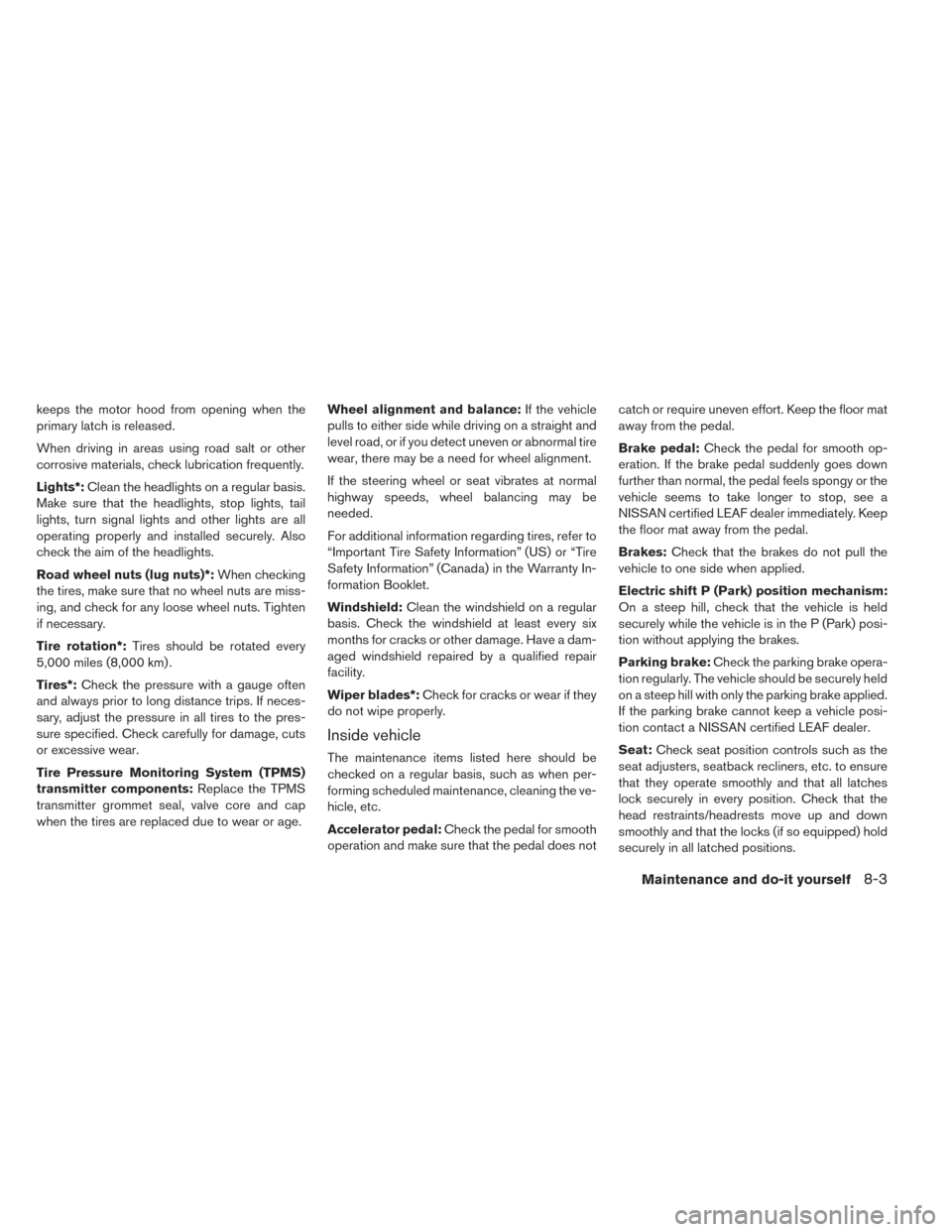
keeps the motor hood from opening when the
primary latch is released.
When driving in areas using road salt or other
corrosive materials, check lubrication frequently.
Lights*:Clean the headlights on a regular basis.
Make sure that the headlights, stop lights, tail
lights, turn signal lights and other lights are all
operating properly and installed securely. Also
check the aim of the headlights.
Road wheel nuts (lug nuts)*: When checking
the tires, make sure that no wheel nuts are miss-
ing, and check for any loose wheel nuts. Tighten
if necessary.
Tire rotation*: Tires should be rotated every
5,000 miles (8,000 km) .
Tires*: Check the pressure with a gauge often
and always prior to long distance trips. If neces-
sary, adjust the pressure in all tires to the pres-
sure specified. Check carefully for damage, cuts
or excessive wear.
Tire Pressure Monitoring System (TPMS)
transmitter components: Replace the TPMS
transmitter grommet seal, valve core and cap
when the tires are replaced due to wear or age. Wheel alignment and balance:
If the vehicle
pulls to either side while driving on a straight and
level road, or if you detect uneven or abnormal tire
wear, there may be a need for wheel alignment.
If the steering wheel or seat vibrates at normal
highway speeds, wheel balancing may be
needed.
For additional information regarding tires, refer to
“Important Tire Safety Information” (US) or “Tire
Safety Information” (Canada) in the Warranty In-
formation Booklet.
Windshield: Clean the windshield on a regular
basis. Check the windshield at least every six
months for cracks or other damage. Have a dam-
aged windshield repaired by a qualified repair
facility.
Wiper blades*: Check for cracks or wear if they
do not wipe properly.
Inside vehicle
The maintenance items listed here should be
checked on a regular basis, such as when per-
forming scheduled maintenance, cleaning the ve-
hicle, etc.
Accelerator pedal: Check the pedal for smooth
operation and make sure that the pedal does not catch or require uneven effort. Keep the floor mat
away from the pedal.
Brake pedal:
Check the pedal for smooth op-
eration. If the brake pedal suddenly goes down
further than normal, the pedal feels spongy or the
vehicle seems to take longer to stop, see a
NISSAN certified LEAF dealer immediately. Keep
the floor mat away from the pedal.
Brakes: Check that the brakes do not pull the
vehicle to one side when applied.
Electric shift P (Park) position mechanism:
On a steep hill, check that the vehicle is held
securely while the vehicle is in the P (Park) posi-
tion without applying the brakes.
Parking brake: Check the parking brake opera-
tion regularly. The vehicle should be securely held
on a steep hill with only the parking brake applied.
If the parking brake cannot keep a vehicle posi-
tion contact a NISSAN certified LEAF dealer.
Seat: Check seat position controls such as the
seat adjusters, seatback recliners, etc. to ensure
that they operate smoothly and that all latches
lock securely in every position. Check that the
head restraints/headrests move up and down
smoothly and that the locks (if so equipped) hold
securely in all latched positions.
Maintenance and do-it yourself8-3
Page 357 of 437
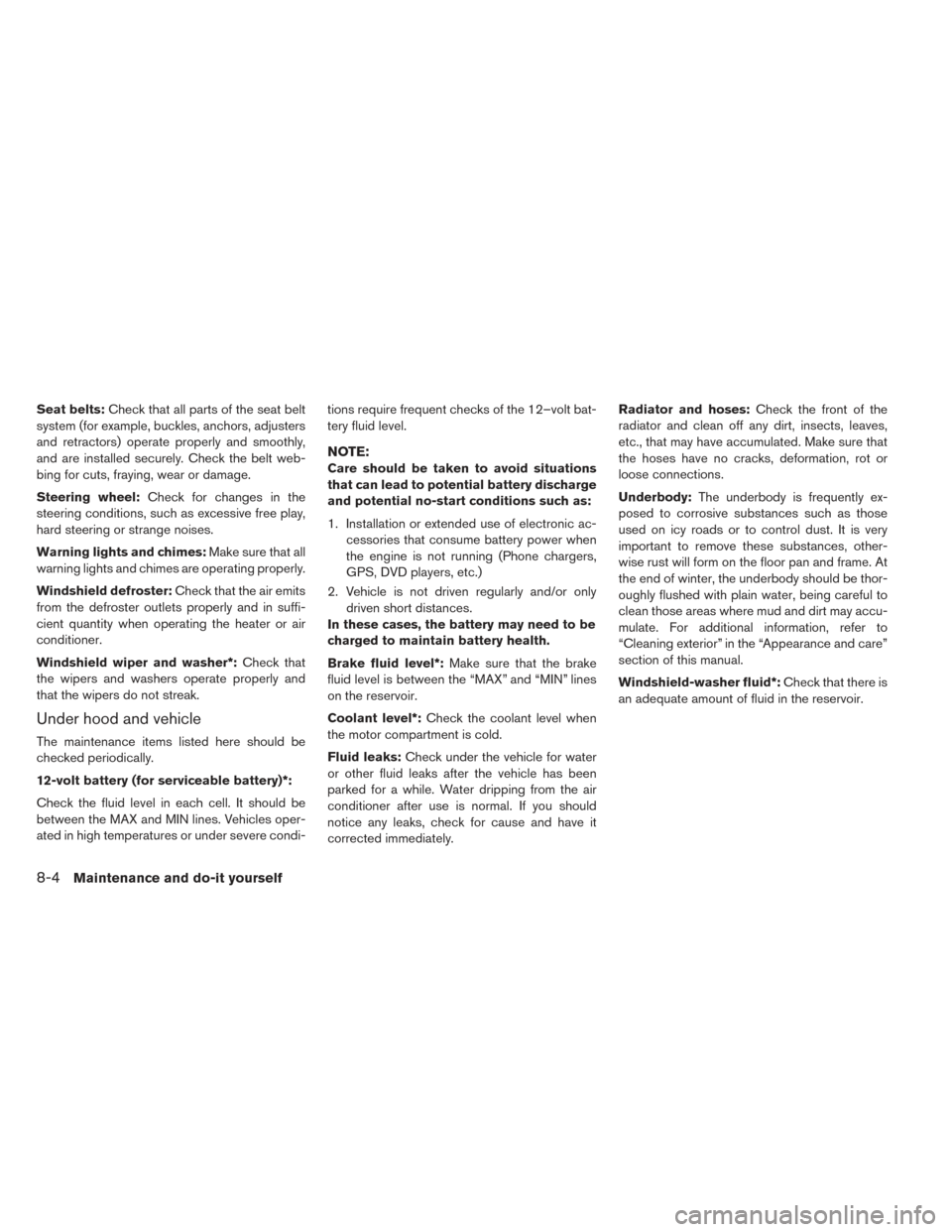
Seat belts:Check that all parts of the seat belt
system (for example, buckles, anchors, adjusters
and retractors) operate properly and smoothly,
and are installed securely. Check the belt web-
bing for cuts, fraying, wear or damage.
Steering wheel: Check for changes in the
steering conditions, such as excessive free play,
hard steering or strange noises.
Warning lights and chimes: Make sure that all
warning lights and chimes are operating properly.
Windshield defroster: Check that the air emits
from the defroster outlets properly and in suffi-
cient quantity when operating the heater or air
conditioner.
Windshield wiper and washer*: Check that
the wipers and washers operate properly and
that the wipers do not streak.
Under hood and vehicle
The maintenance items listed here should be
checked periodically.
12-volt battery (for serviceable battery)*:
Check the fluid level in each cell. It should be
between the MAX and MIN lines. Vehicles oper-
ated in high temperatures or under severe condi- tions require frequent checks of the 12–volt bat-
tery fluid level.
NOTE:
Care should be taken to avoid situations
that can lead to potential battery discharge
and potential no-start conditions such as:
1. Installation or extended use of electronic ac-
cessories that consume battery power when
the engine is not running (Phone chargers,
GPS, DVD players, etc.)
2. Vehicle is not driven regularly and/or only driven short distances.
In these cases, the battery may need to be
charged to maintain battery health.
Brake fluid level*: Make sure that the brake
fluid level is between the “MAX” and “MIN” lines
on the reservoir.
Coolant level*: Check the coolant level when
the motor compartment is cold.
Fluid leaks: Check under the vehicle for water
or other fluid leaks after the vehicle has been
parked for a while. Water dripping from the air
conditioner after use is normal. If you should
notice any leaks, check for cause and have it
corrected immediately. Radiator and hoses:
Check the front of the
radiator and clean off any dirt, insects, leaves,
etc., that may have accumulated. Make sure that
the hoses have no cracks, deformation, rot or
loose connections.
Underbody: The underbody is frequently ex-
posed to corrosive substances such as those
used on icy roads or to control dust. It is very
important to remove these substances, other-
wise rust will form on the floor pan and frame. At
the end of winter, the underbody should be thor-
oughly flushed with plain water, being careful to
clean those areas where mud and dirt may accu-
mulate. For additional information, refer to
“Cleaning exterior” in the “Appearance and care”
section of this manual.
Windshield-washer fluid*: Check that there is
an adequate amount of fluid in the reservoir.
8-4Maintenance and do-it yourself
Page 416 of 437
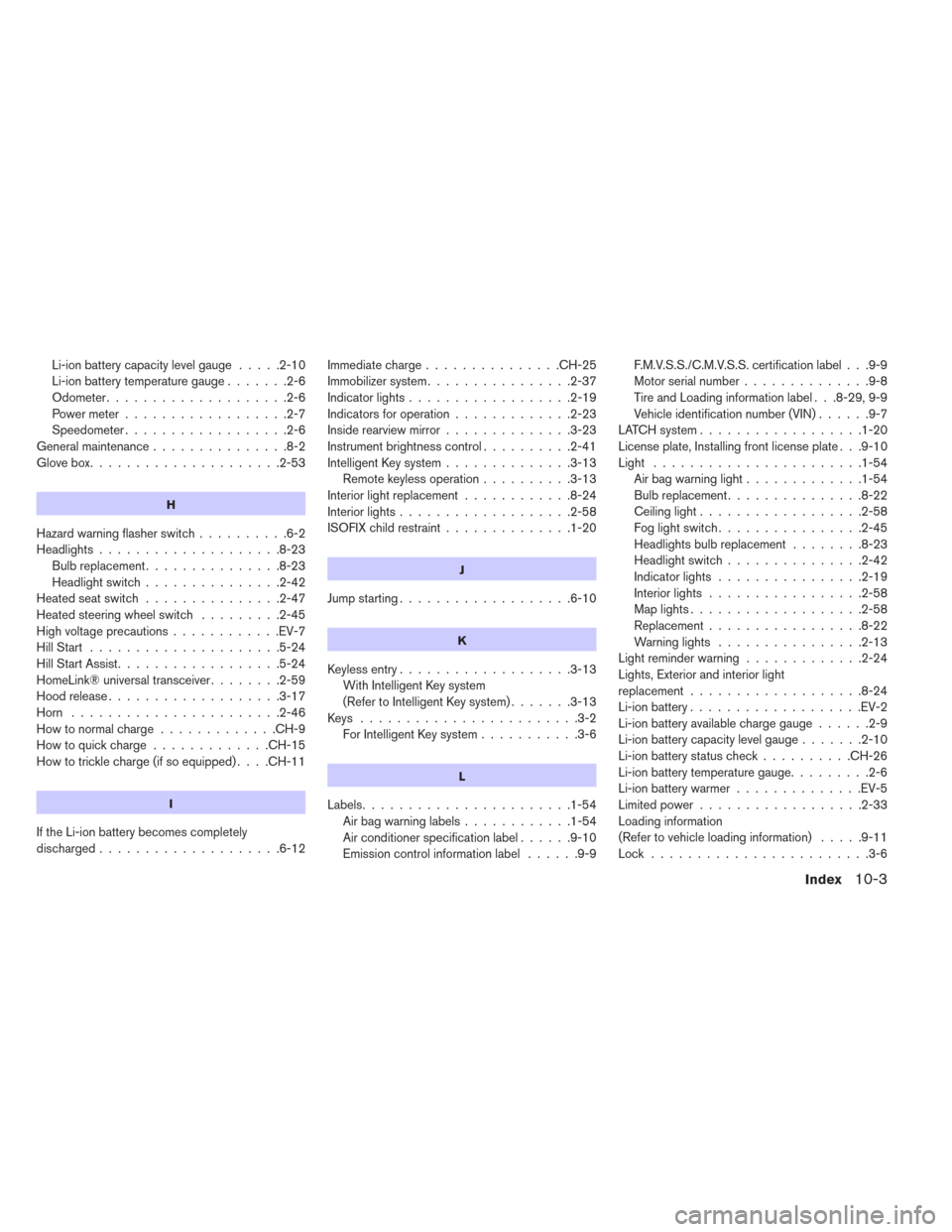
Li-ion battery capacity level gauge.....2-10
Li-ion battery temperature gauge .......2-6
Odometer ....................2-6
Power meter ..................2-7
Speedometer ..................2-6
Generalmaintenance...............8-2
Glovebox.....................2-53
H
Hazard warning flasher switch ..........6-2
Headlights ....................8-23
Bulb replacement ...............8-23
Headlightswitch...............2-42
Heatedseatswitch ...............2-47
Heated steering wheel switch .........2-45
High voltage precautions ............EV-7
HillStart .....................5-24
Hill Start Assist ..................5-24
HomeLink® universal transceiver ........2-59
Hood release ...................3-17
Horn .......................2-46
Howtonormalcharge.............CH-9
Howtoquickcharge.............CH-15
How to trickle charge (if so equipped) ....CH-11
I
If the Li-ion battery becomes completely
discharged....................6-12 Immediate charge
...............CH-25
Immobilizer system ................2-37
Indicatorlights..................2-19
Indicators for operation .............2-23
Inside rearview mirror ..............3-23
Instrument brightness control ..........2-41
Intelligent Key system ..............3-13
Remote keyless operation ..........3-13
Interior light replacement ............8-24
Interior lights ...................2-58
ISOFIX child restraint ..............1-20
J
Jump starting...................6-10
K
Keylessentry...................3-13
With Intelligent Key system
(Refer to Intelligent Key system) .......3-13
Keys ........................3-2 For Intelligent Key system ...........3-6
L
Labels.......................1-54
Airbagwarninglabels............1-54
Air conditioner specification label ......9-10
Emission control information label ......9-9F.M.V.S.S./C.M.V.S.S. certification label . . .9-9
Motor serial number
..............9-8
Tire and Loading information label . . .8-29, 9-9
Vehicle identification number (VIN) ......9-7
LATCH system ..................1-20
License plate, Installing front license plate . . .9-10
Light .......................1-54 Airbagwarninglight.............1-54
Bulb replacement ...............8-22
Ceiling light ..................2-58
Fog light switch ................2-45
Headlightsbulbreplacement ........8-23
Headlightswitch...............2-42
Indicatorlights ................2-19
Interiorlights .................2-58
Maplights...................2-58
Replacement.................8-22
Warning lights ................2-13
Lightreminderwarning .............2-24
Lights, Exterior and interior light
replacement ...................8-24
Li-ion battery ...................EV-2
Li-ion battery available charge gauge ......2-9
Li-ion battery capacity level gauge .......2-10
Li-ion battery status check ..........CH-26
Li-ion battery temperature gauge .........2-6
Li-ion battery warmer ..............EV-5
Limited power ..................2-33
Loading information
(Refer to vehicle loading information) .....9-11
Lock ........................3-6
Index10-3
Page 418 of 437
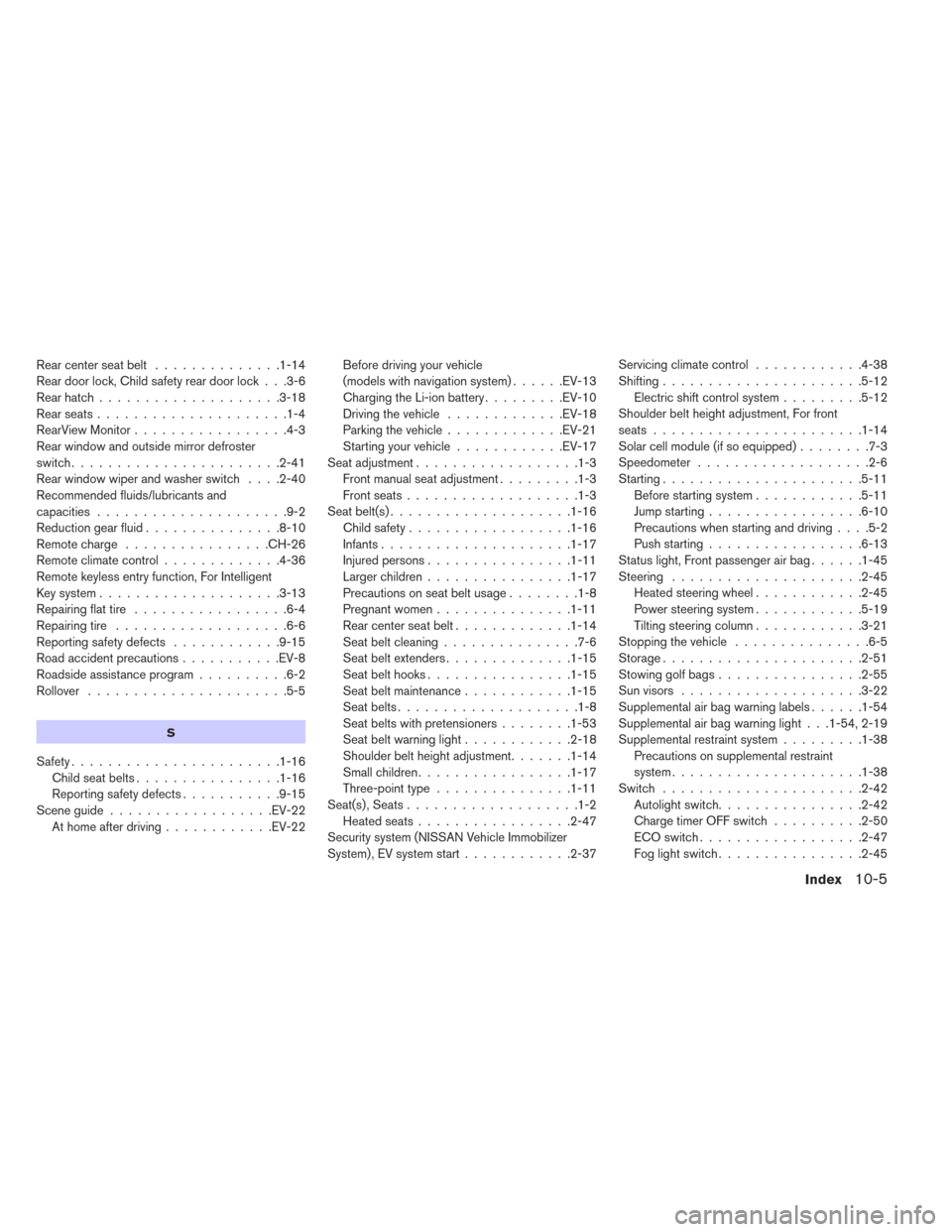
Rearcenterseatbelt ..............1-14
Rear door lock, Child safety rear door lock . . .3-6
Rear hatch....................3-18
Rearseats.....................1-4
RearView Monitor .................4-3
Rear window and outside mirror defroster
switch .......................2-41
Rear window wiper and washer switch ....2-40
Recommended fluids/lubricants and
capacities .....................9-2
Reductiongearfluid...............8-10
Remotecharge ................CH-26
Remoteclimatecontrol.............4-36
Remote keyless entry function, For Intelligent
Keysystem....................3-13
Repairing flat tire .................6-4
Repairing tire ...................6-6
Reporting safety defects ............9-15
Road accident precautions ...........EV-8
Roadside assistance program ..........6-2
Rollover ......................5-5
S
Safety .......................1-16
Childseatbelts................1-16
Reporting safety defects ...........9-15
Sceneguide..................EV-22 At home after driving ............EV-22 Before driving your vehicle
(models with navigation system)
......EV-13
Charging the Li-ion battery .........EV-10
Driving the vehicle .............EV-18
Parking the vehicle .............EV-21
Starting your vehicle ............EV-17
Seat adjustment ..................1-3
Front manual seat adjustment .........1-3
Frontseats...................1-3
Seat belt(s) ....................1-16
Child safety ..................1-16
Infants.....................1-17
Injuredpersons................1-11
Largerchildren................1-17
Precautions on seat belt usage ........1-8
Pregnant women ...............1-11
Rear center seat belt .............1-14
Seatbeltcleaning...............7-6
Seatbeltextenders..............1-15
Seat belt hooks ................1-15
Seat belt maintenance ............1-15
Seatbelts....................1-8
Seat belts with pretensioners ........1-53
Seatbeltwarninglight............2-18
Shoulder belt height adjustment .......1-14
Smallchildren.................1-17
Three-point type ...............1-11
Seat(s) , Seats ...................1-2
Heatedseats.................2-47
Security system (NISSAN Vehicle Immobilizer
System) , EV system start ............2-37 Servicing climate control
............4-38
Shifting ......................5-12
Electric shift control system .........5-12
Shoulder belt height adjustment, For front
seats .......................1-14
Solar cell module (if so equipped) ........7-3
Speedometer ...................2-6
Starting ......................5-11
Before starting system ............5-11
Jump starting .................6-10
Precautions when starting and driving ....5-2
Push starting .................6-13
Status light, Front passenger air bag ......1-45
Steering .....................2-45 Heated steering wheel ............2-45
Power steering system ............5-19
Tilting steering column ............3-21
Stopping the vehicle ...............6-5
Storage......................2-51
Stowing golf bags ................2-55
Sun visors ....................3-22
Supplemental air bag warning labels ......1-54
Supplemental air bag warning light . . .1-54, 2-19
Supplemental restraint system .........1-38
Precautions on supplemental restraint
system .....................1-38
Switch ......................2-42 Autolight switch ................2-42
Charge timer OFF switch ..........2-50
ECO switch ..................2-47
Fog light switch ................2-45
Index10-5